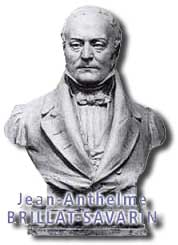
|
When Nutrition is an Art Eighteenth-century chef Jean Anthelme Brillat-Savarin can be considered the godfather of modern, practical nourishment |
info@nutritionaladvisor.com Athens News JUST as Antoine Laurent Lavoisier, the first and perhaps the greatest modern chemist, may be hailed as the father of theoretical nutrition, so Jean Anthelme Brillat-Savarin may be acclaimed as the godfather of modern, practical nutrition. He might have been a lawyer by training and a magistrate by profession, but he was a gastronome by vocation. The epoch, though, was hard on both men. In 1975 during the French Revolution, Lavoisier was condemned to death because some of his friends were royalists, and he lost his head to the guillotine. Accused of a similar crime, and seeking to avoid the same fate, Brillat-Savarin secretly crossed the Swiss frontier and went to Lausanne before emigrating across the Atlantic. There he survived by giving French lessons and playing his Stradivarius violin in a New York theatre orchestra (one hopes partly for his pleasure). He is known mainly for and from his book, The Physiology of Taste, published privately in 1825, a few months before his death. With chapters “On the Senses”, “The Theory of Frying”, “On the Pleasures of the Table”, “Gastronomical Tests” and so on, the text goes beyond nutrition and the table to those refined regions where the pleasures of the flesh merge with the delights of the spirit. A free thinker, following the natural bent of his genius wherever it might take him, he did not hesitate to risk the disfavour of his compatriots on an especially touchy subject. “I am deeply persuaded that French, the language I use, is comparatively poor in resources. What is to be done in such a case? I must borrow, or steal. I do both, since my borrowings are not subject to a decree of restitution, and a theft of words is no offence according to the penal code.” Beasts feed; man eats; the man of intellect alone knows how to dine. A couple of his sayings are particularly appropriate for Greece. “The most indispensable quality in a cook is punctuality; and no less is required of a guest.” And next: “To wait too long for an unpunctual guest is an act of discourtesy towards those who have arrived in time.” Would that the hosts and hostesses of this country might learn something from this apostle of responsibility to our gut. I have only one tiny difference with Brillat-Savarin. In his chapter on gastronomy, he describes it as “the reasoned comprehension of all that relates to the nourishment of man”. Today his definition far better fits the science of nutrition. If I were to put on his magisterial gown, and find myself pressed to elaborate on this term in ten words, I think I would say that “gastronomy is the elevation of simple sustenance into ambrosial art”. At the right are two simple recipes which derive from French regional cookery. At its best, this is the most delicious in the world; cookery which uses raw materials to greatest advantage without going to the absurd lengths of complicated haute cuisine. Recipes Oeufs a` la Monteynard Serves 4 Carmel
|
|

